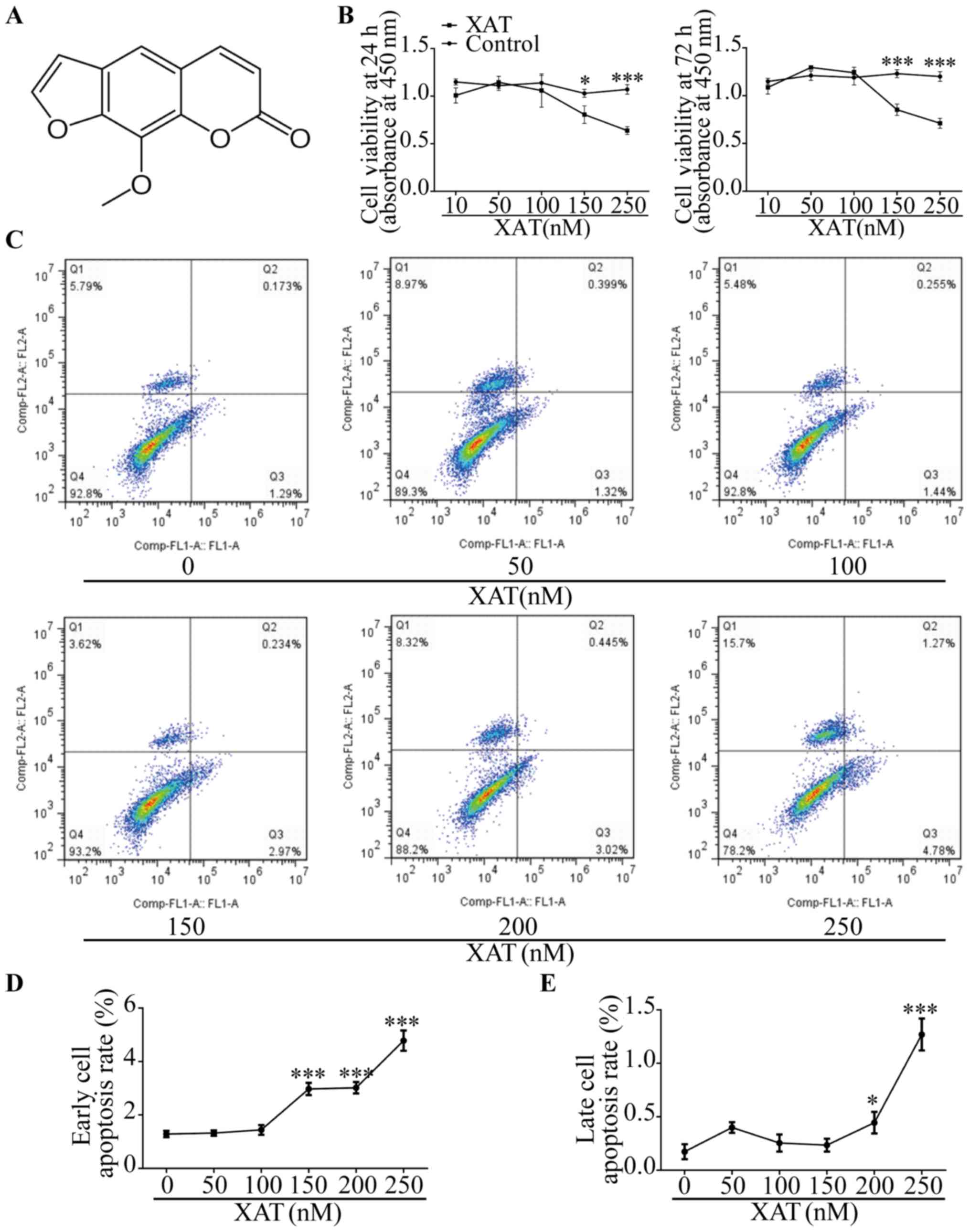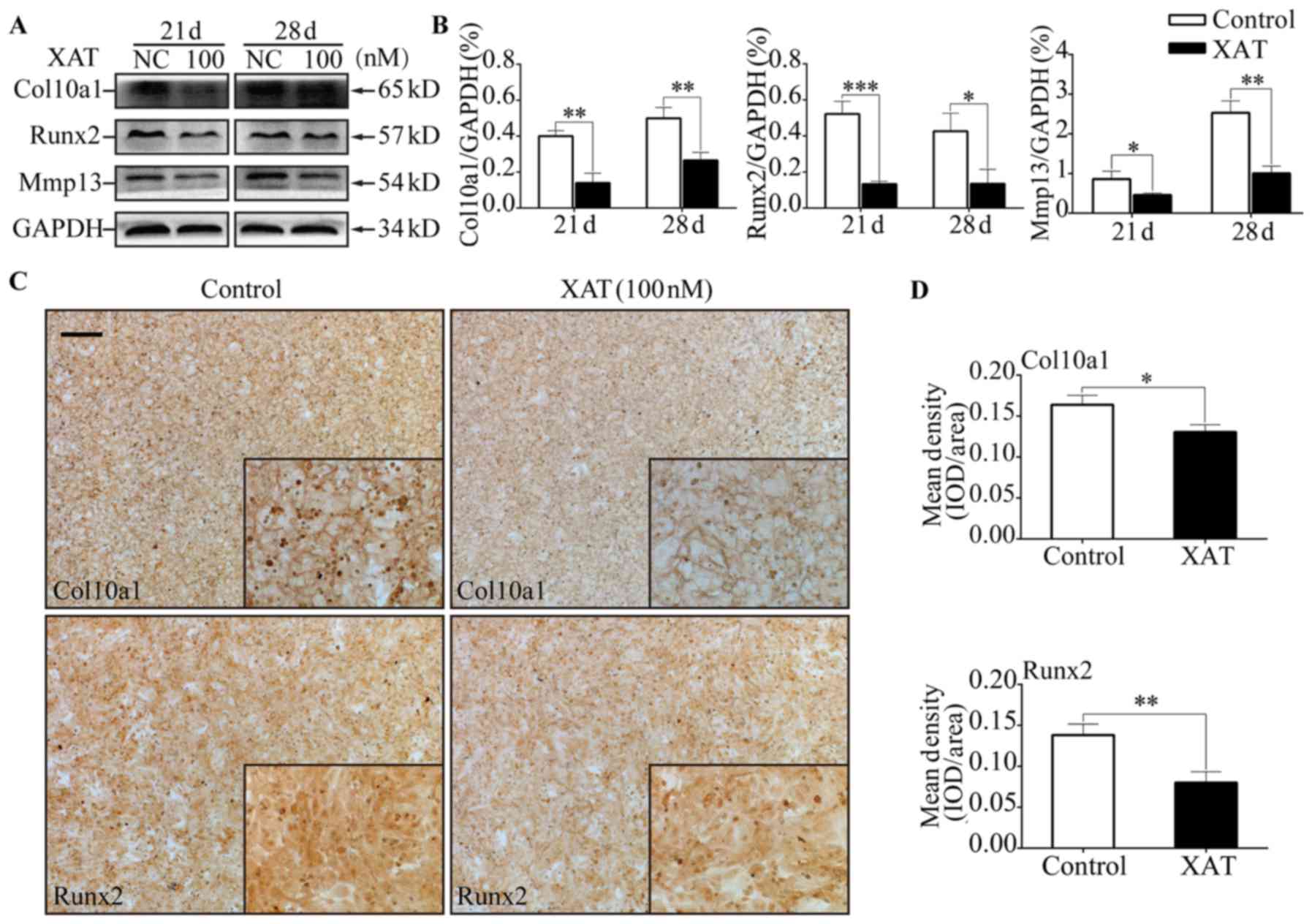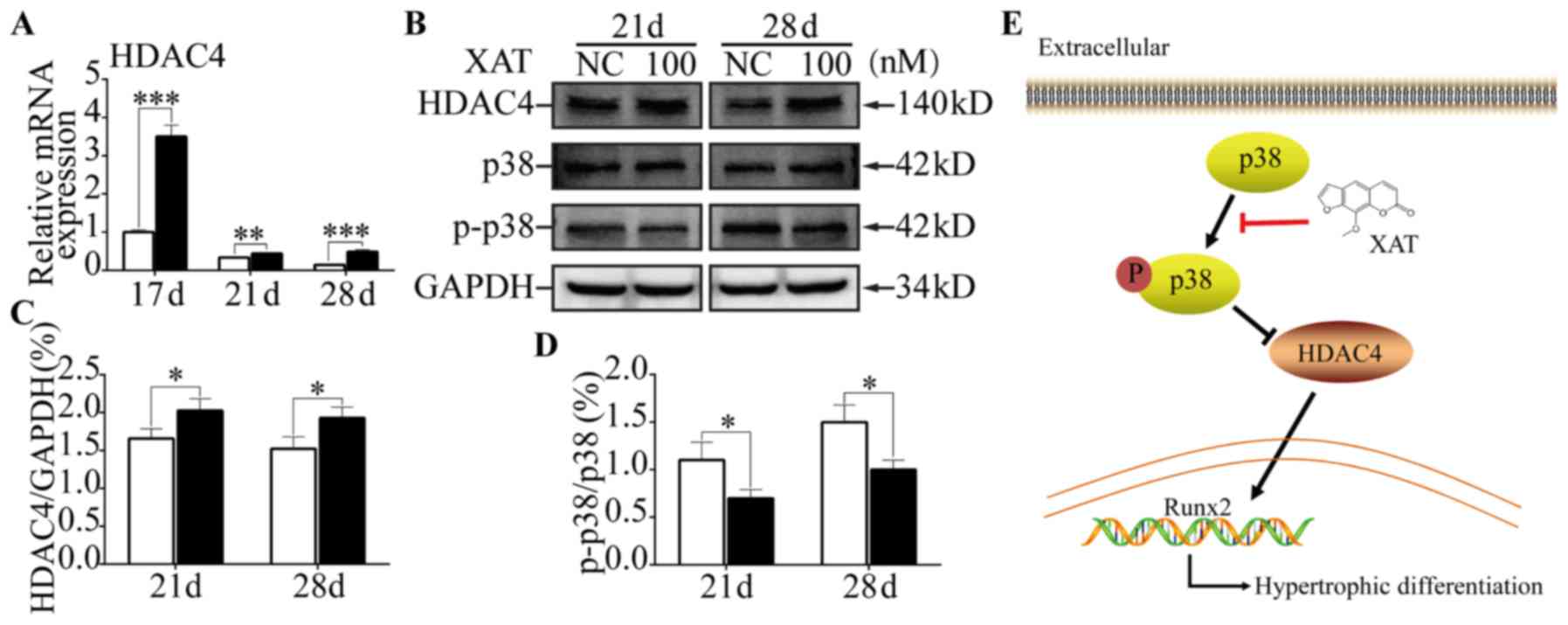|
1
|
Hinton RJ, Jing Y, Jing J and Feng JQ:
Roles of chondrocytes in endochondral bone formation and fracture
repair. J Dent Res. 96:23–30. 2017. View Article : Google Scholar : PubMed/NCBI
|
|
2
|
Long F and Ornitz DM: Development of the
endochondral skeleton. Cold Spring Harb Perspect Biol.
5:a0083342013. View Article : Google Scholar : PubMed/NCBI
|
|
3
|
Cancedda R, Castagnola P, Cancedda FD,
Dozin B and Quarto R: Developmental control of chondrogenesis and
osteogenesis. Int J Dev Biol. 44:707–714. 2000.PubMed/NCBI
|
|
4
|
Glyn-Jones S, Palmer AJ, Agricola R, Price
AJ, Vincent TL, Weinans H and Carr AJ: Osteoarthritis. Lancet.
386:376–387. 2015. View Article : Google Scholar : PubMed/NCBI
|
|
5
|
Bianchi A, Guibert M, Cailotto F, Gasser
A, Presle N, Mainard D, Netter P, Kempf H, Jouzeau JY and Reboul P:
Fibroblast growth factor 23 drives MMP13 expression in human
osteoarthritic chondrocytes in a Klotho-independent manner.
Osteoarthritis Cartilage. 24:1961–1969. 2016. View Article : Google Scholar : PubMed/NCBI
|
|
6
|
Wang T, Lai JH and Yang F: Effects of
hydrogel stiffness and extracellular compositions on modulating
cartilage regeneration by mixed populations of stem cells and
chondrocytes in vivo. Tissue Eng Part A. 22:1348–1356. 2016.
View Article : Google Scholar : PubMed/NCBI
|
|
7
|
Di Luca A, Szlazak K, Lorenzo-Moldero I,
Ghebes CA, Lepedda A, Swieszkowski W, Van Blitterswijk C and Moroni
L: Influencing chondrogenic differentiation of human mesenchymal
stromal cells in scaffolds displaying a structural gradient in pore
size. Acta Biomater. 36:210–219. 2016. View Article : Google Scholar : PubMed/NCBI
|
|
8
|
Garg BJ, Garg NK, Beg S, Singh B and
Katare OP: Nanosized ethosomes-based hydrogel formulations of
methoxsalen for enhanced topical delivery against vitiligo:
Formulation optimization, in vitro evaluation and preclinical
assessment. J Drug Target. 24:233–246. 2016. View Article : Google Scholar
|
|
9
|
Archier E, Devaux S, Castela E, Gallini A,
Aubin F, Le Maître M, Aractingi S, Bachelez H, Cribier B, Joly P,
et al: Carcinogenic risks of psoralen UV-A therapy and narrowband
UV-B therapy in chronic plaque psoriasis: A systematic literature
review. J Eur Acad Dermatol Venereol. 26:(Suppl 3). S22–S31. 2012.
View Article : Google Scholar
|
|
10
|
Yang H, Xiong J, Luo W, Yang J and Xi T:
8-Methoxypsoralen induces intrinsic apoptosis in HepG2 cells:
Involvement of reactive oxygen species generation and ERK1/2
pathway inhibition. Cell Physiol Biochem. 37:361–374. 2015.
View Article : Google Scholar : PubMed/NCBI
|
|
11
|
Panno ML, Giordano F, Palma MG, Bartella
V, Rago V, Maggiolini M, Sisci D, Lanzino M, De Amicis F and Andò
S: Evidence that bergapten, independently of its photoactivation,
enhances p53 gene expression and induces apoptosis in human breast
cancer cells. Curr Cancer Drug Targets. 9:469–481. 2009. View Article : Google Scholar : PubMed/NCBI
|
|
12
|
Zagaja M, Andres-Mach M, Patrzylas P,
Pyrka D, Szpringer M, Florek-Łuszczki M, Żółkowska D,
Skalicka-Woźniak K and Łuszczki JJ: Influence of xanthotoxin
(8-methoxypsoralen) on the anticonvulsant activity of various novel
antiepileptic drugs against maximal electroshock-induced seizures
in mice. Fitoterapia. 115:86–91. 2016. View Article : Google Scholar : PubMed/NCBI
|
|
13
|
Livak KJ and Schmittgen TD: Analysis of
relative gene expression data using real-time quantitative PCR and
the 2(−Delta Delta C(T)) method. Methods. 25:402–408. 2001.
View Article : Google Scholar : PubMed/NCBI
|
|
14
|
Tian W, Cai J, Xu Y, Luo X, Zhang J, Zhang
Z, Zhang Q, Wang X, Hu L and Lin G: Determination of xanthotoxin
using a liquid chromatography-mass spectrometry and its application
to pharmacokinetics and tissue distribution model in rat. Int J
Clin Exp Med. 8:15164–15172. 2015.PubMed/NCBI
|
|
15
|
Wolnicka-Glubisz A, Sarna T, Klosner G,
Knobler R and Trautinger F: UVA activated 8-MOP and chlorpromazine
inhibit release of TNF-alpha by post-transcriptional regulation.
Photochem Photobiol Sci. 3:334–336. 2004. View Article : Google Scholar : PubMed/NCBI
|
|
16
|
Chen YF, Tsai HY and Wu TS:
Anti-inflammatory and analgesic activities from roots of
Angelica pubescens. Planta Med. 61:2–8. 1995. View Article : Google Scholar : PubMed/NCBI
|
|
17
|
Ng TB, Liu F and Wang ZT: Antioxidative
activity of natural products from plants. Life Sci. 66:709–723.
2000. View Article : Google Scholar : PubMed/NCBI
|
|
18
|
Caron MMJ, Emans PJ, Surtel DA, van der
Kraan PM, van Rhijn LW and Welting TJ: BAPX-1/NKX-3.2 acts as a
chondrocyte hypertrophy molecular switch in osteoarthritis.
Arthritis Rheumatol. 67:2944–2956. 2015. View Article : Google Scholar : PubMed/NCBI
|
|
19
|
de Oliveira DM, Lima RM Ferreira,
Clarencio J, Velozo Eda S, de Amorim IA, da Andrade Mota TH, Costa
SL, Silva FP and El-Bachá Rdos S: The classical photoactivated drug
8-methoxypsoralen and related compounds are effective without UV
light irradiation against glioma cells. Neurochem Int. 99:33–41.
2016. View Article : Google Scholar : PubMed/NCBI
|
|
20
|
Dou C, Chen Y, Ding N, Li N, Jiang H, Zhao
C, Kang F, Cao Z, Quan H, Luo F, et al: Xanthotoxin prevents bone
loss in ovariectomized mice through the inhibition of RANKL-induced
osteoclastogenesis. Osteoporosis Int. 27:2335–2344. 2016.
View Article : Google Scholar
|
|
21
|
Liu CF, Samsa WE, Zhou G and Lefebvre V:
Transcriptional control of chondrocyte specification and
differentiation. Semin Cell Dev Biol. 62:34–49. 2017. View Article : Google Scholar : PubMed/NCBI
|
|
22
|
Guo F, Han X, Wu Z, Cheng Z, Hu Q, Zhao Y,
Wang Y and Liu C: ATF6a, a Runx2-activable transcription factor, is
a new regulator of chondrocyte hypertrophy. J Cell Sci.
129:717–728. 2016. View Article : Google Scholar : PubMed/NCBI
|
|
23
|
Takeda S, Bonnamy JP, Owen MJ, Ducy P and
Karsenty G: Continuous expression of Cbfa1 in nonhypertrophic
chondrocytes uncovers its ability to induce hypertrophic
chondrocyte differentiation and partially rescues Cbfa1-deficient
mice. Genes Dev. 15:467–481. 2001. View Article : Google Scholar : PubMed/NCBI
|
|
24
|
Yamashita S, Andoh M, Ueno-Kudoh H, Sato
T, Miyaki S and Asahara H: Sox9 directly promotes Bapx1 gene
expression to repress Runx2 in chondrocytes. Exp Cell Res.
315:2231–2240. 2009. View Article : Google Scholar : PubMed/NCBI
|
|
25
|
Kanzler B, Kuschert SJ, Liu YH and Mallo
M: Hoxa-2 restricts the chondrogenic domain and inhibits bone
formation during development of the branchial area. Development.
125:2587–2597. 1998.PubMed/NCBI
|
|
26
|
Chen W, Sheng P, Huang Z, Meng F, Kang Y,
Huang G and Zhang Z, Liao W and Zhang Z: MicroRNA-381 regulates
chondrocyte hypertrophy by inhibiting histone deacetylase 4
expression. Int J Mol Sci. 17:E13772016. View Article : Google Scholar : PubMed/NCBI
|
|
27
|
Vega RB, Matsuda K, Oh J, Barbosa AC, Yang
X, Meadows E, McAnally J, Pomajzl C, Shelton JM, Richardson JA, et
al: Histone deacetylase 4 controls chondrocyte hypertrophy during
skeletogenesis. Cell. 119:555–566. 2004. View Article : Google Scholar : PubMed/NCBI
|
|
28
|
Li P, Wei X, Guan Y, Chen Q, Zhao T, Sun C
and Wei L: MicroRNA-1 regulates chondrocyte phenotype by repressing
histone deacetylase 4 during growth plate development. FASEB J.
28:3930–3941. 2014. View Article : Google Scholar : PubMed/NCBI
|
|
29
|
Wang L, Bai YY, Yang Y, Hu F, Wang Y, Yu
Z, Cheng Z and Zhou J: Diabetes mellitus stimulates pancreatic
cancer growth and epithelial-mesenchymal transition-mediated
metastasis via a p38 MAPK pathway. Oncotarget. 7:38539–38550. 2016.
View Article : Google Scholar : PubMed/NCBI
|
|
30
|
Mota CM, Oliveira AC, Davoli-Ferreira M,
Silva MV, Santiago FM, Nadipuram SM, Vashisht AA, Wohlschlegel JA,
Bradley PJ, Silva JS, et al: Neospora caninum activates p38 MAPK as
an evasion mechanism against innate immunity. Front Microbiol.
7:14562016. View Article : Google Scholar : PubMed/NCBI
|
|
31
|
Zhou JM, Li PC, Chen Q, Wei X, Zhao T,
Wang Z and Wei L: Mitogen-activated protein kinase p38 induces
HDAC4 degradation in hypertrophic chondrocytes. Biochim Biophys
Acta. 1853:370–376. 2015. View Article : Google Scholar : PubMed/NCBI
|
|
32
|
Kung LH, Zaki S, Ravi V, Rowley L, Smith
MM, Bell KM, Bateman JF and Little CB: Utility of circulating serum
miRNAs as biomarkers of early cartilage degeneration in animal
models of post-traumatic osteoarthritis and inflammatory arthritis.
Osteoarthritis Cartilage. 25:426–434. 2017. View Article : Google Scholar : PubMed/NCBI
|
|
33
|
Doran PM: Cartilage tissue engineering:
What have we learned in practice? Methods Mol Biol. 1340:3–21.
2015. View Article : Google Scholar : PubMed/NCBI
|













